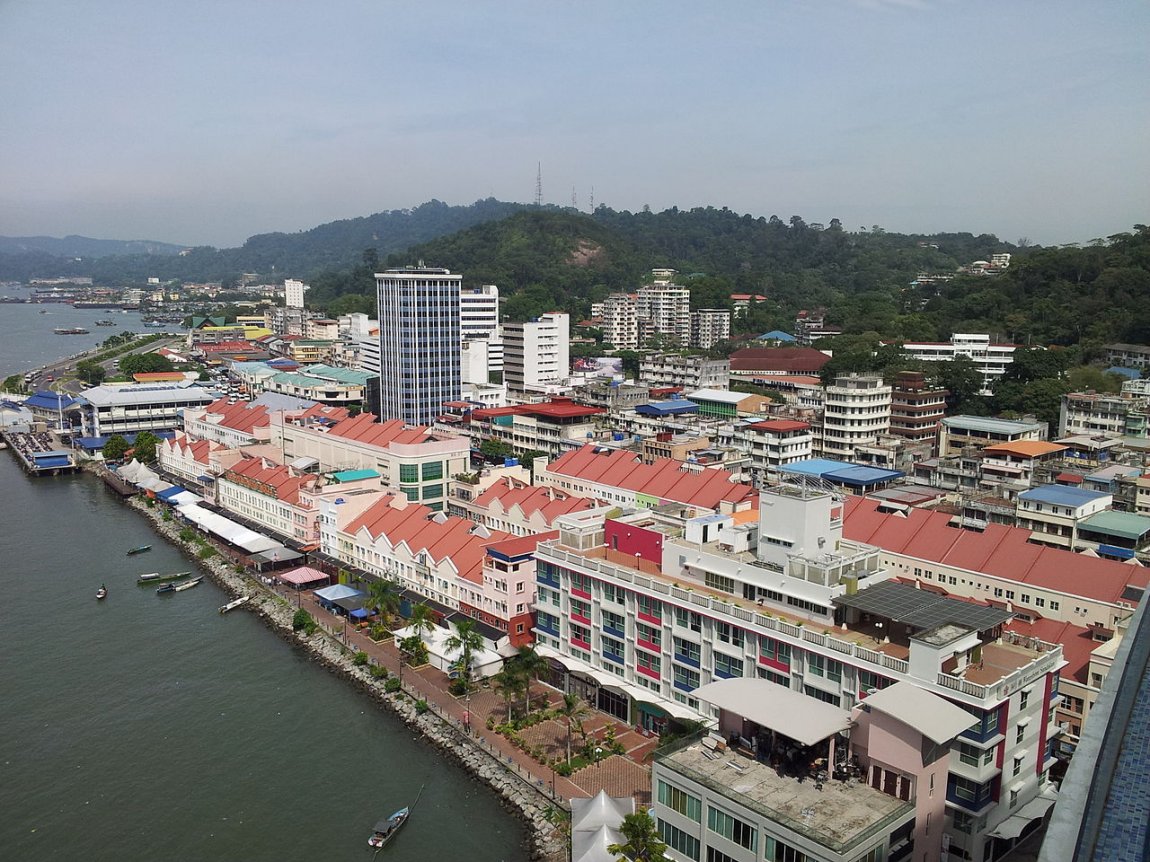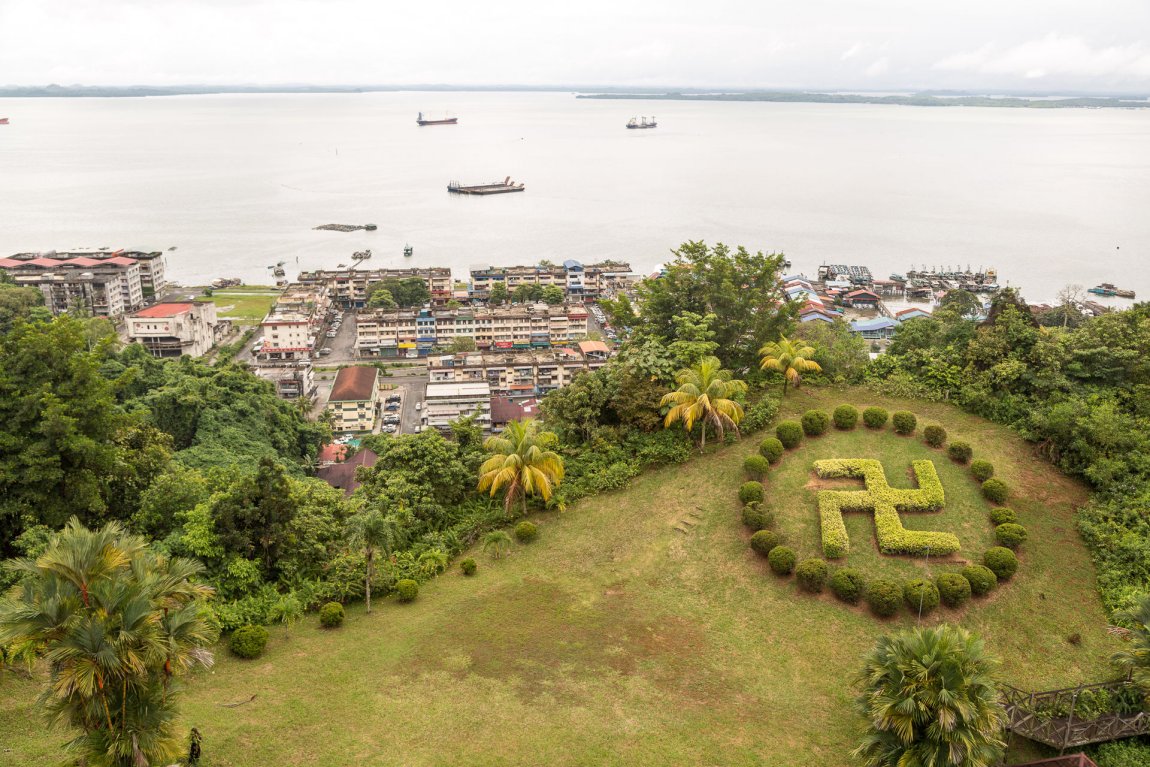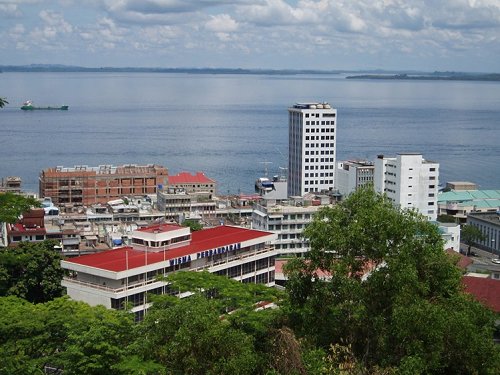 Sandakan, Sabah
Sandakan, Sabah https://commons.wikimedia.org/wiki/Category:Panoramic_and_aerial_views_of_Sandakan#/media/File:Sandakan_1.jpg
https://commons.wikimedia.org/wiki/Category:Panoramic_and_aerial_views_of_Sandakan#/media/File:Sandakan_1.jpg Atlasmotor
Atlasmotor
Sandakan (GPS: 5.83944, 118.11717) is a major town in Sabah. It is located on the north-eastern coast of Sabah, and is the administrative capital of the Sandakan Division. This moderate size town was the capital of Sabah between 1883 and 1945, when the state was known as British North Borneo. Today it is the second largest city in Sabah.
Map of Sandakan, Sabah
Sights in Sandakan
- Agnes Keith House
- Anglican Church of St Thomas
- Batu Sapi
- Batu Tulug
- Calvary Charismatic Church
- Centre Point Mall
- Che Siang Khor Moral Uplifting Society
- Church of the Good Shepherd
- English Tea House
- Harbour Mall
- Hong San Tze Temple
- Japanese Cemetery
- Kampung Berhala Darat
- Kampung Buli Sim Sim
- Kinabatangan Wildlife Sanctuary
- Kun Yam Temple
- Leila Baptist Church
- Masjid Jamek Sandakan
- Pulau Berhala
- Puu Jih Shih Buddhist Temple
- Qilin Temple
- Rainforest Discovery Centre
- Rotary Observation Pavilion
- Sam Sing Kung Temple
- Sandakan Airport
- Sandakan Baptist Church
- Sandakan Crocodile Farm
- Sandakan Golf and Country Club
- Sandakan Harbour Square
- Sandakan Heritage Museum
- Sandakan Memorial Park
- Sandakan Mosque
- Sandakan New Market
- Sandakan Recreation Club
- Sandakan Yacht Club
- Sepilok Orang Utan Rehabilitation Centre
- Seventh Day Adventist Church
- Star Cineplex
- St Mary Catholic Church
- St Michael's and All Angels Church
- Tam Kung Temple
- Trigg Hill
- True Jesus Church
Categories of sights in Sandakan
History of Sandakan
Until 1870, the east coast of Sabah was part of the Sultanate of Sulu. William Clarke Cowie, a gun smuggler from Scotland, was granted rights by the Sultan of Sulu to establlish a trading base there. It was Cowie who gave the place the name Sandakan. It means "the place that was pawned" in the Tausug language of the Sulu people.In 1878, a German settlement was also established there by Baron von Overbeck. However, the settlement was destroyed by fire the year after, and was never rebuilt. Instead a new British Resident to North Borneo, William Burges Pryer, established a new settlement, called Elopura, at Buli Sim Sim. Both Elopura and Buli Sim Sim remains to this day as place names in Sandakan.
 Sandakan as seen from Puu Jih Shih Temple
Sandakan as seen from Puu Jih Shih Temple https://commons.wikimedia.org/wiki/Category:Puu_Jih_Shih_Temple#/media/File:Sandakan_Sabah_PuuJihShihTemple-17.jpg
https://commons.wikimedia.org/wiki/Category:Puu_Jih_Shih_Temple#/media/File:Sandakan_Sabah_PuuJihShihTemple-17.jpg CEphoto, Uwe Aranas
CEphoto, Uwe Aranas
 Sandakan
Sandakan https://commons.wikimedia.org/wiki/File:Sandakan_from_The_English_Tea_House.jpg
https://commons.wikimedia.org/wiki/File:Sandakan_from_The_English_Tea_House.jpg Tony Jones
Tony Jones
The main activity in Sandakan, especially in the mid-1930s, was timber. It brought prosperity to the boom town and allowed it to replace Kudat as the capital. Following the liberation from Japanese Occupation in 1945, the capital was shifted once again, to Jesselton, which was subsequently renamed Kota Kinabalu.
Sandakan is today the second most important seaport in Sabah after Kota Kinabalu, exporting substantial quantities of commodities including palm oil, tobacco, cocoa, coffee, manila hemp and sago. The timber industry has taken a backseat over the commodities. The Pan Borneo Highway passes through Sandakan, connecting it with the the other major towns of Sabah, as well as with Sarawak and Brunei.
Getting there
By PlaneSandakan Airport (SDK) has regular flights by Malaysia Airlines to Kota Kinabalu and by AirAsia to Kuala Lumpur.
By Road There are regular bus services connecting Sandakan with Kota Kinabalu's North Bus Terminal in Inanam. The journey takes about six hours, and the fare is about RM60. By the way, the bus passes the junction to Sepilok Orang Utan Rehabilitation Centre on its way to Sandakan. You can ask to be dropped off at the Sepilok bus stop, from where you can get a taxi to the santuary, which is 4 km down the road. Taxis are often waiting at that bus stop. It will cost you about RM5 for the ride.
What to do in Sandakan
Perhaps the only must-see sight while in Sandakan is a visit to the Sepilok Orang Utan Rehabilitation Centre. Other than that, you can walk around the town, explore the waterfront.You can expect more activities within 2-3 hours from Sandakan. There are numerous national parks and mangrove swamps to explore, caves for spelunking, and river cruises to take. Check out the tourist attractions near Sandakan that I have listed out below.
Sandakan is  on the Map of Sabah
on the Map of Sabah
Back to Discover Sabah
 Latest updates on Penang Travel Tips
Latest updates on Penang Travel Tips
 Discover with Timothy videos on Sabah
Discover with Timothy videos on Sabah
What to see when in Sabah? Here are some suggestions from my videos.Disclaimer
Please use the information on this page as guidance only. The author endeavours to update the information on this page from time to time, but regrets any inaccuracies if there be any.
Copyright © 2003-2025 Timothy Tye. All Rights Reserved.

 Go Back
Go Back